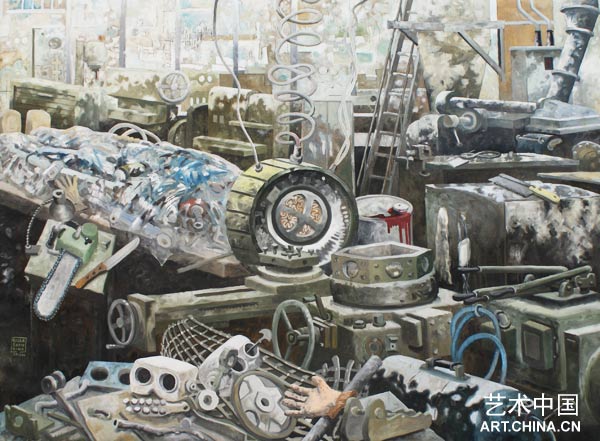|

此次,东京画廊+BTAP举办大岩·奥斯卡尔个展《亚洲厨房》。此次,大岩的中国大陆首次展览,不仅要展示艺术家亲自造访中国,现地取材,创作的无论从尺寸还是内容上都宏伟壮大的5张大型油画新作,还将展示艺术家以往的画作、版画作品。
大岩.奥斯卡尔1965年出生于巴西圣保罗系第2代日裔巴西人。幼年时代漫画的耳濡目染,使大岩逐渐从中学、高中开始创作作品,进而在大学时代就出展多个展览会,在巴西开始了其现代艺术家的历程。1989年于圣保罗大学建筑学部毕业后,为了寻求更加广阔的创作空间,大岩辗转与东京(1991~2001年)、纽约(2002年~)之间。直面每个城市的环境与历史,通过艺术家自身在每个城市中的生活经历,将自己的亲身感受与独创的幽默交织在一起融入作品。
2008年7月,大岩访问了奥运会即将揭幕的北京,在这次首次访华的经历中,大岩分别造访了BTAP的所在地北京798艺术区和城市繁华区,目睹了急速发展的中国,感慨万分:“亚洲时代必定以中国为中心开始”。大岩将在北京逗留期间发现的各种各样的互无关联的绘画元素,自由自在的进行组合,创作的作品展现了具有独特且丰富的想像力和深厚故事性的亚洲世界。繁华区一隅,废弃物遍地的幽暗土地;钢水如瀑布一般飞泻的工厂内部之风景等等。大岩从多方面捕捉亚洲之实态,用超越现实的氛围和魄力十足的画风,描绘出亚洲的万种风情。虽然作品内容以亚洲为中心,但是这些作品的题材归根结底还是围绕着大城市的均一化、能源问题、产业国际化、经济问题等等不只局限于亚洲的全球性问题。称自己为"地球人"的大岩冷静地与国际性社会的整体问题对峙,并且将其与自身的世界观融和在一起。
大岩在其作品中没有描绘人物,他事先考虑到观赏者之存在,进而创作作品。那种深入画境的感觉,对于观赏者来说无疑是一种深奥的妙趣。此次展览会展出的作品中有横幅5.5M的超大作品。在这些压倒性比例的作品面前,初次面对大岩作品的中国人之间会诞生何种话题呢?
在致本展览的文章中,大岩诠释到 :
"看到我的作品,人们会猜到我是哪国人吗?虽然成长的环境以及后来居住的场所对于世界观和人生观有所影响;但是我认为单纯出现在作品中的内容是无国籍的。也就是说,我只是一个单纯的地球人。此次展览,大多是以亚洲为焦点的作品,但是大城市的国际化、能源问题、衰败的经济、跨国界产业等等也是世界共同之课题。⋯⋯即使近代文明发源于西洋社会,但是现在地球上的超高层大厦的2/3建于亚洲。我认为亚洲时代必定以中国为中心开始。我想把这篇文章送给散策于798艺术区的年轻人。希望他们放眼世界,理解其他人的存在以及他们的文化,度过有意义的一生。我能够在北京展览,很高兴的感觉到地球是一个大家庭。"
大岩.奥斯卡尔(纽约.2009年1月29日)
值此,诚邀您莅临观赏以急速发展的亚洲为出发点,用独创的视角描绘出我们周边之社会的《Asian Kitchen》展。5月16日下午15:00时举行展览开幕式,届时本展览的画册也将同步发行。
'if you direct your eyes more to the outer world and understand there are so many and various peoples and cultures on the earth, you can lead a very interesting life.'
Oscar Oiwa
New York, January 29th, 2009
Tokyo Gallery + BTAP presents a solo exhibition by Oscar Oiwa entitled "Asian Kitchen." This is Oiwa's first exhibition in China, centering on 5 massive new oil paintings whose size and narrative are both based on the artist’s firsthand experience of China, as well as older prints and other works.
Oiwa is a second-generation Japanese Brazilian born in 1965 in Sao Paolo, Brazil. He became familiar with manga comics from an early age, and slowly began making work during his junior high and high school days. While still enrolled at university, he started exhibiting his work at several exhibitions, launching his career as a contemporary artist in Brazil. After graduating from the department of architecture at the University of Sao Paolo in 1989, and seeking to widen the scope of his practice as an artist, Oiwa shifted his base first to Tokyo (1991-2001), and then to New York (2002-). By drawing on his own life experiences in each city and confronting its urban environment and history, Oiwa interweaves a sense of humor entirely his own with his understanding of the world in his work.
In July 2008, Oiwa visited Beijing, a city just then on the verge of a wave of pre-Olympic excitement. During his stay, while walking through Beijing's Dashanzi Art District and other parts of the city, Oiwa experienced firsthand the sense of dynamism brought about by rapid development, leaving him with no doubt that "the new Asian era will have China as its center."
Oiwa's new works made after returning home consist of a free combination of diverse, apparently disconnected elements that attracted his interest during his stay in China. The result is a vision of Asia imbued with a unique imaginative power and sense of narrative. In these scenes of bustling downtown areas, depressing tracts of land buried in waste, and the insides of factories where waterfalls of molten iron flow through and spill over, Oiwa captures the diverse realities of Asia, depicting its many faces with a forceful style and somewhat fantastical atmosphere that appears to transcend reality.
Although Oiwa's paintings depict Asia, their underlying themes are global ones that are not limited to this region alone: the homogenization of large cities, energy crises, the globalization of industry and economic problems. Oiwa, who calls himself an "earthling," confronts the problems of the global community as a whole with calm self-possession and conflates them with his own personal view of the world.
Another characteristic feature of Oiwa's paintings is the absence of people. Oiwa paints while taking his audience into consideration in advance, and viewers of his work revel particularly in the feeling of being drawn into the painting. Among the works on display at this exhibition are large scale paintings measuring 5.5 meters wide. One can only wonder what sort of dialogue might emerge between Chinese people seeing Oiwa's work for the first time, standing in front of these paintings with their massive, overwhelming sense of scale.
The following is an excerpt from an essay written by Oiwa for this exhibition:
'I wonder, just like my accent, can my work give clues to people to see where I have come from ? I am sure that deep in my head and mind, there are many influences from how I was raised and where I lived afterwards, but things appearing in my paintings simply have no nationality - I take myself just as an earthling. Although many of the exhibited works in this show may seem to focus on Asia, on issues such as big cities under internationalization, energy problems, increasingly depressed economies, transnational industries, and so on. I think these are not only Asian but also global concerns. [abbr] Industrial revolution began in the West, but today, two-thirds of super high-rise buildings are actually in Asia. In my opinion, it is quite certain that the time of Asia will start with China as its center. Looking in from the outside, information from other countries seems to be secretly under governmental control in China. I would like to send a message to the young people who are strolling through 798 Art Zone, in which BTAP is located, and who are reading this text right now, that if you direct your eyes more to the outer world and understand there are so many and various peoples and cultures on the earth, you can lead a very interesting life. I am very happy to have this exhibition in Beijing, which enables me to feel the earth as a single country.'
Oscar Oiwa
New York, January 29th, 2009
We hope you take this opportunity to view "Asian Kitchen," an exhibition that addresses the society at large that surrounds us by taking Asia and its rapid growth as its point of departure. In addition, an opening reception in the presence of the artist will be held on May 16th (Sat) starting at 15:00. A catalog of works on display will also be published to coincide with the exhibition.
|

